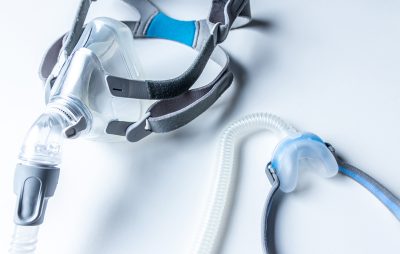
While most people might think of sleep apnea as a mere annoyance because their partner is snoring loudly, the truth is sleep apnea can be quite dangerous. In the short term, sleep apnea can cost you a good night’s sleep. Over the long term, sleep apnea can lead to more serious health issues like high blood pressure and diabetes. Untreated sleep apnea can also increase your risk of heart attack and stroke. The most common form of sleep apnea is obstructive sleep apnea (OSA), and CPAP devices are the benchmark for treating the disorder.
Note: The content on Sleepopolis is meant to be informative in nature, but it shouldn’t be taken as medical advice, and it shouldn’t take the place of medical advice and supervision from a trained professional. If you feel you may be suffering from any sleep disorder or medical condition, please see your healthcare provider immediately.
What Is Sleep Apnea?
“An apnea is a short pause in breathing while sleeping, usually due to the tongue or other mouth tissue blocking the throat,” says Dr. Igal Elyassi, founder of The Sleep Apnea Center. He tells Sleepopolis that when they do occur, the brain prompts the individual to breathe deeper, subsequently waking them up. Elyassi notes that sleep apnea can be quite disruptive to restorative sleep as apneas can occur hundreds of times per night. Moreover, the individual who experiences the apnea is typically unaware it’s happening — it’s often a partner who alerts the individual to signs of trouble. Out of the 70 million Americans who suffer from sleep disorders, about 25 million suffer from sleep apnea.
What Does A CPAP Machine Do?
According to Dr. Katherine Hall, a sleep psychologist at Somnus Therapy, continuous positive airway pressure (or CPAP) devices are the gold standard for treating obstructive sleep apnea. “CPAP therapy involves using a machine that delivers air through a mask worn during sleep,” says Hall. “The air pressure provided by the machine keeps the airway open, preventing pauses in breathing and restoring normal sleep patterns.”
Are There Different Types Of CPAP Machines?
There are three types of CPAP devices; CPAP, BiPAP, and APAP. Dr. Michael Grandner, an internationally recognized expert on sleep and health and advisor to Sleep Reset, notes that while these devices are different, “they all work essentially the same way. They blow air through a tube into a mask that the patient wears.” Digging a little deeper, he tells Sleepopolis that “most machines have water tanks that keep the air from getting too dry, heating elements to keep the air comfortably warm, and features that make the flow of air more comfortable.”
The Differences Between A CPAP, BiPAP, And APAP
Essentially, PAP machines differ in how they deliver air pressure. CPAPs deliver constant air pressure, APAPs auto-adjust to changes in pressure, and BiPAPs provide varying levels of pressure.
CPAP
As its name implies, CPAP devices, or continuous positive airway pressure devices, deliver a constant flow of pressure to your airways while you sleep. Also known as a fixed-level CPAP, a sleep specialist usually determines and pre-programs the device’s air pressure during an overnight sleep study.
APAP
Again, as its name implies, APAP or auto-adjusting PAP machines adjust their air pressure level based on individual breathing patterns. Unlike CPAP devices, the air pressure level delivered by an APAP is calculated by the device rather than pre-programmed by a sleep specialist during a sleep study. While upper and lower limits of air pressure may be preset on the device, the air pressure delivered to the person’s airway at any given moment will fluctuate based on changes to their breathing patterns.
BiPAP
BiPAP devices deliver two air pressure levels, one for inhalation and another for exhalation. Typically, BiPAP devices deliver higher-pressure air on the inhale and lower pressure on the exhale. These PAP devices are often reserved for patients who don’t respond well to traditional CPAP therapy, patients with severe breathing issues, or those with other breathing-related conditions like central sleep apnea.
The Pros And Cons Of Using A CPAP
While CPAP devices have plenty of well-documented benefits, research shows they have a low compliance rate, which is attributed to discomfort. This means that many people choose to go untreated instead of using their CPAP devices, which opens them up to short- and long-term side effects.
Pros Of CPAP Devices
Perhaps the most notable benefits of CPAP devices are their positive effect on health outcomes for their users. Studies have shown that CPAP therapy:
- Reduces sleep fragmentation
- Decreases daytime sleepiness
- Lowers blood pressure
- Mitigates cardiovascular risk
- Reduce blood glucose and cholesterol levels
Cons Of CPAP Devices
According to Elyassi, “CPAP is effective for a majority of users. However, there is a high non-compliance rate because the devices can be uncomfortable to wear and require lying on one’s back all night. CPAPs can also have side effects, such as a sore throat, nose congestion, and skin or eye irritation.”
Reported (and documented) issues with CPAP include:
- Nasal discomfort
- Airway dryness/dry mouth
- Discomfort with the apparatus or a feeling of claustrophobia
- Anxiety
- Inconvenience
- Frequent nighttime waking
- Partner complaints about noise from the machine
How To Clean A CPAP Machine
CPAP devices are a remarkable tool for treating obstructive sleep apnea, but keeping them clean is crucial. Not only can germs from your lungs, throat, or mouth contaminate the mask or hose, but germs can also be transferred from your skin into the mask or hose. Dust, mold, and other allergens are also a concern. CPAP machines should be cleaned regularly to keep germs and contaminants in check so they don’t make you sick or damage your machine.
While most detachable CPAP parts can be cleaned with mild soap and water, you should read your owner’s manual before you dive in.
- Unplug your device.
- Disconnect the air hose and tubing from the mask and the CPAP machine.
- Wash each part of your mask separately with mild soap.
- Clean the inside of the tubing by submerging the tube in warm soapy water (make sure it has a chance to fill completely with water).
- Repeat the same steps as above for your hose.
- Wash the cushion and headgear with mild soap.
- Rinse all components with cool, clean water.
- Lay the components out on a clean towel to air dry.
- Water can settle in the hoses and tubing, so you might consider hanging these components to ensure thorough drying.
- Give all parts a once-over with a dry towel.
- Reassemble the components of your CPAP device.
Are CPAP Machines Covered By Insurance?
Obstructive sleep apnea is a recognized sleep disorder, so health insurance providers will usually cover the cost of CPAP devices. That said, you may want to check the terms of your policy and read the fine print, as some policies require a certain level of compliance for coverage.
For example, Medicare typically covers a three-month trial for CPAP therapy, but users must use the machine consistently to qualify for ongoing coverage.
In other cases, compliance data is transmitted from your machine to the insurance provider by way of the company that supplies your machine. If the insurance company finds that you don’t use your CPAP machine regularly, they may stop paying for the device altogether.
Alternative Treatments for Sleep Apnea
“In some cases, CPAP therapy may not be the best option for treating sleep apnea,” says Hall. “For example, if you have mild sleep apnea, you may be able to treat your condition with lifestyle changes such as weight loss, quitting smoking, and sleeping on your side. If these changes are not enough to improve your sleep apnea, your doctor may recommend an oral appliance, a mouthguard-like device that keeps your airway open during sleep. Surgery is another option for treating sleep apnea, but it is usually only recommended for severe cases that have not responded to other treatments.”
Positional Therapy
Sleeping in a supine position can exacerbate or worsen the symptoms of OSA. So, in what may be the simplest approach for treating sleep apnea, patients can try positional therapy. Just as its name implies, you can try sleeping on your stomach or sides to prevent apneic episodes, ultimately improving your sleep quality.
Weight Loss
Obesity is a major risk factor for sleep apnea, and studies show that shedding a few pounds can significantly improve the symptoms of sleep apnea. In some cases, dramatic weight loss can even cure sleep apnea.
Oral Appliances
The use of oral appliances like mouthguards can help keep the tongue in place or ease the jaw forward, keeping the airway open and free of obstructions.
Oral Surgery
People who have large tonsils or extra tissue in their throat may be predisposed to obstructive sleep apnea. In those cases, oral surgery may be the best bet to help them breathe easier.
Inspire Therapy
While CPAP therapy has been the reigning champ for the treatment of obstructive sleep apnea, there’s a new device on the market that treats obstructive sleep apnea without discomfort. The first of its kind, Inspire is an implantable device that treats sleep apnea via remote control. When activated, Inspire monitors nighttime breathing and sends a pulse every time the person takes a breath so the tongue can be gently moved to open the airway. Ultimately, the device keeps the airway open throughout the night so the patient can breathe freely.
The Last Word From Sleepopolis
Sleep apnea is the most common sleep disorder, affecting about 25 million people, but there are effective treatments out there for those affected. While CPAP devices are the gold standard for treating sleep apnea, they may not work for everyone. If you find that CPAP therapy is too uncomfortable to use consistently, consider speaking with your doctor about alternate treatments and the future of sleep apnea treatment.



























